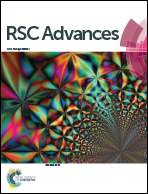Enhancement of protein production by microalgae Dunaliella salina under mixotrophic conditions using response surface methodology†
Abstract
The present work was aimed at enhancing the protein production in Dunaliella salina by optimization of culture conditions. The interactive effects of medium composition on protein production were optimized using response surface methodology (RSM). A mathematical model was proposed to describe the kinetics of D. salina growth. Results showed that the mixotrophic effects were in conjunction with those of the mixture of NaCl and glucose. Based on the optimization study, protein production in D. salina could be markedly increased through glucose supplementation as low as 5 g L−1. Optimal conditions were achieved at 288, 288 and 312 h with a doubling time of 1.13, 3.03 and 5.17 days for D1, D2 and D3 strains, respectively. The overall protein production was enhanced by 3.4, 3.9 and 14 times in D1, D2 and D3, respectively. The microplate-based approach enabled us to screen large numbers of experimental cultures in a time and cost effective manner. It also can be concluded that reducing the growth cycle through this cultivation system may expedite the analysis of transformants for production of recombinant proteins in microalgae.


 Please wait while we load your content...
Please wait while we load your content...